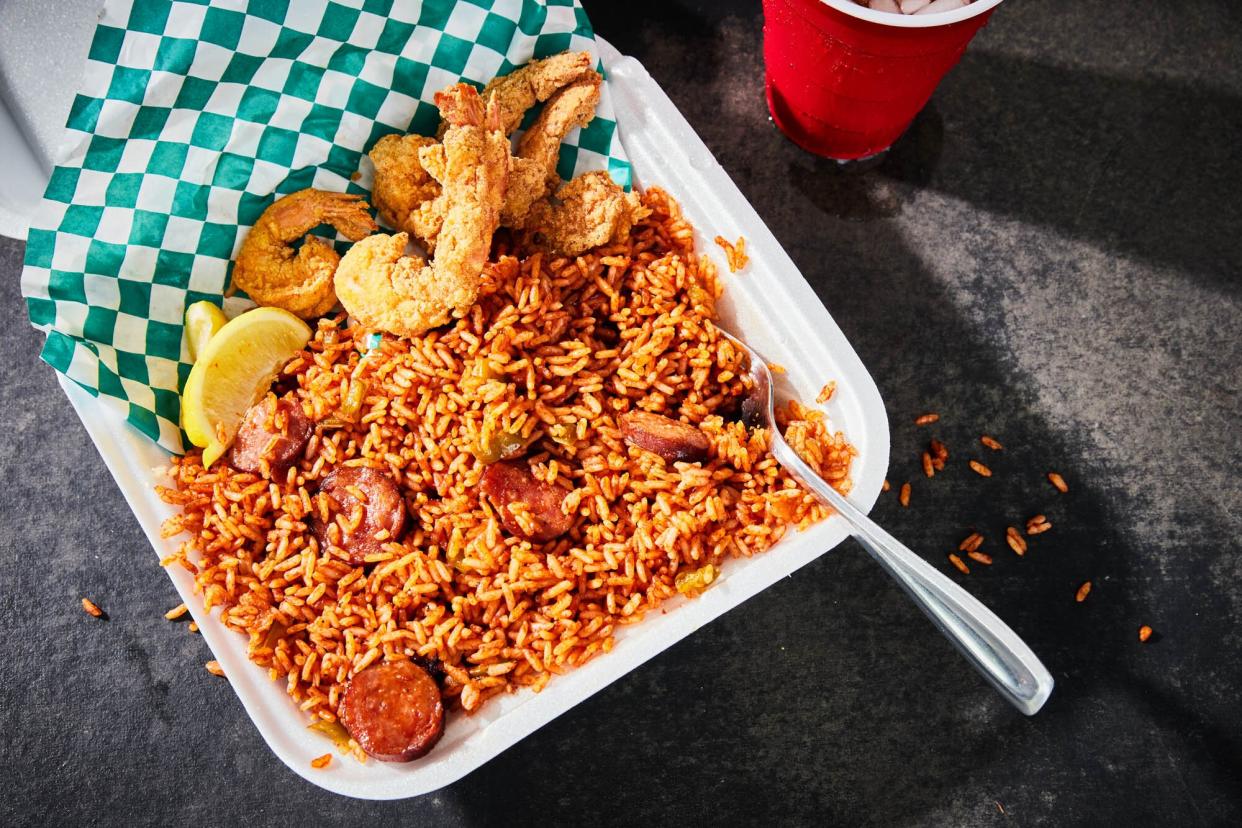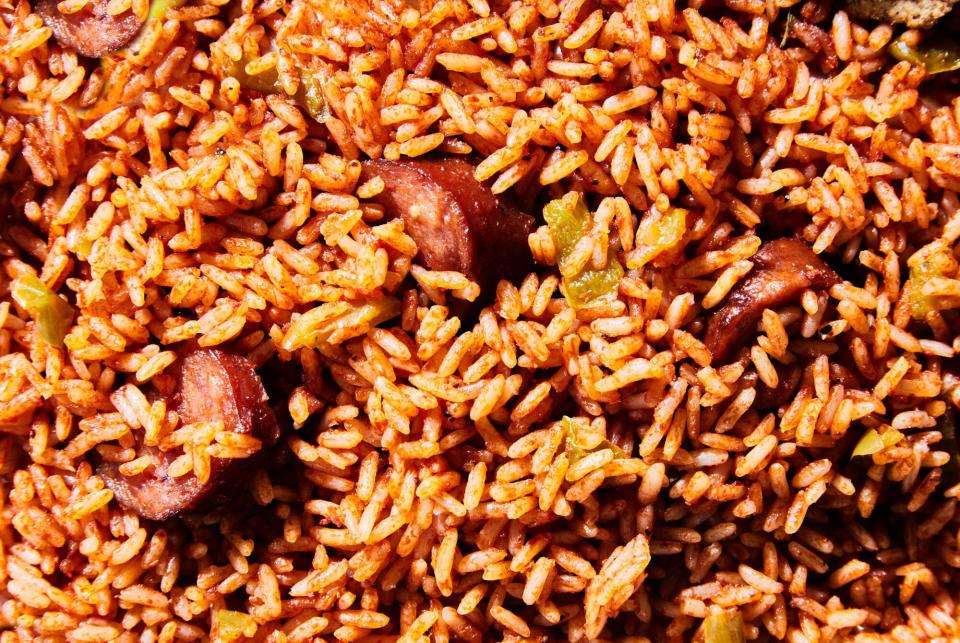No, You Can't Have My Red Rice Recipe

Peter Frank Edwards Lowcountry red rice and fried shrimp from Chanel's Gullah Cuisine in Charleston, South Carolina.
I am intensely protective over my red rice recipe. Truthfully, no one knows how I make it and it's one of those things that took me years to get just right. What does that even mean really—just right? Most people don't even know what red rice is, let alone what it should taste or look like and how it should or could be made.
READ MORE: Rice Is Everything: A Celebration of the World's Most Popular Food
You say "red rice" to someone outside of the Lowcountry of South Carolina and Georgia, and their first assumption is something similar to Spanish or Mexican-style rice, maybe even jambalaya if I'm lucky to have this conversation with someone else familiar with Southern dishes. While all are tomato-based rice dishes, the three I just mentioned are vastly different from my beloved red rice. It's more than just a derivative of jollof or thieboudienne, although we honor our mother dishes just as we honor our connections to all of the things that came before us and that we carry with us today. Tomato perloo, pilau, or pilaf (depending on where you're from) is the truest way to describe this dish.
Red rice is home.
It's the result of hundreds of years perfecting the one-pot dish, passing it down more often than not, from one woman to another. Red rice is home. It's fish fries and family. Sunday suppers with vast spreads of food across the table—greens and cornbread, macaroni and cheese, okra and tomatoes, white rice too—and plenty of hands to pass around the dishes. It's a meal not easily made for one or two; it's meant to be shared like it was shared with us from our ancestors in West Africa who carried on their knowledge of growing rice and growing American civilizations. They took an ingredient they knew, and without their native red palm oil, they used the tomatoes the Spanish introduced to their diets and created something of their own.
READ: The Wide World of Jollof Rice
It took me years to finally perfect my red rice recipe; no one person in particular taught me. Truthfully it was an accumulation of different women across different parts of my life who each added their own little tips and tricks which led me to the "recipe" I go by now. I couldn't tell you any precise measurements for it if I tried. And even if for some reason I did have a written recipe, you could make it, but you could never make it with the same intention and care as Black Lowcountrians.
The swish of your hands across the grains is like casting a spell.
Generally, when the conversation of rice comes up on social media or in person, I try to make a point of saying how the simple act of washing rice alone is spiritual—knowing what temperature of water to use, how much it should be rinsed depending on how you're cooking it, picking out tiny little stones or imperfections, the way you do it all with intention. The swish of your hands across the grains is like casting a spell. I'd been taught to put so much thought and consideration into making rice for my entire life, so it's always funny to me when people hear me and then respond, "You wash your rice?" For most of my life, so far as I knew, there was no other way to prepare the grain. It's another tradition passed down through a shared maternal memory from what seems like eons ago.

Peter Frank Edwards Chef Vivian Peterson's Lowcountry red rice at Chanel's Gullah Cuisine in Charleston, South Carolina.
READ: Valerie Erwin Is a Steward of Rice History
Now, there are a few different ways you can make red rice. It can be vegetarian or loaded with meat and seafood. It can be made with fresh tomatoes or canned, paste, or sauce, on top of the stove or in the oven. For me, the ideal texture is slightly dry, has a hint of spice, smoke, and sweetness, each grain is separate and fluffy, and it's all a little shiny from the rendered fat it's cooked in. Each of the unique ways it can be done is a living legacy of each person and the people before them who passed on the ability to make it. When I sit down to a plate or bowl of red rice, I could be eating it as a side dish or I could just be eating it on its own—especially if it has meat, and the meat to rice to vegetable ratio is on point. I like when it's made for a side at cookouts and barbecues and a little of the rice touches my potato salad and picks up on the smoke from the charcoal-grilled chicken. Or, with fried whiting and shrimp, and a generous helping of hot sauce. For Thanksgiving and Christmas dinners, baby showers and weddings, it's on the table.
It's more than nostalgia. It is salt water on your skin and a marshy breeze in your hair.
When I eat it, I am instantly transported for a moment to a place that exists outside of time and space. It's not just the dish your grandma used to make perfectly that you can't quite recreate, it's not your mom's favorite way to gussy up Kraft macaroni and cheese. It's more than nostalgia. It is salt water on your skin and a marshy breeze in your hair. It's the way every grandma's house in the South smells the same, like a well-worn and welcoming home. It's sweetgrass and haint blue on your window sills and door frames. Wafting smells of peppers and onions, and simmering tomato cooking with the rice. It's the coffee can or mason jar of bacon grease that sits near the stove.
READ: Put Some Respect on the Bacon Grease Jar
Fluffy, never mushy, perfectly cooked. I like when I get a little of the rice that's been cooked 'til crispy around the edges or bottom of the pot or pan, the sugars from the vegetables creating a caramelized bit of crunch that pops in my mouth when I chew. It's a very simple dish without a lot of added seasonings or ingredients, and also very complex and difficult to make. Carrying on legacy and tradition is often a heavy burden to bear, but nothing lightens the load like getting the dish right and the approval of your loved ones.
MAKE: Alexander Smalls' Carolina Fish, Shrimp, and Okra Stew with Black Rice
But that feeling extends beyond blood, because when you can make a good pan or dish of red rice, it's like an entire nation all on its own approves. It gives you a level of confidence and pride that only the designated macaroni and cheese or pie makers at any family function would understand. But it's also special, because it's not just a dish that ties us to our pasts, but also carries into our futures—being able to go to my homegirls and talking about our recipes and having younger family members ask to learn how to make it, realizing that by making it through years of trial and error, I've begun to root myself into the ways of elders and aunties and grannies before me. I'm a new generation brought into the fold. Red rice is a gift you have to be touched with to make, and a blessing for your soul if you ever get to taste it.
You can't have Amethyst's recipe, but these are a few places she recommends trying it:
Charleston, South Carolina
Chanel's Gullah Cuisine (pictured at the top)
Bertha's Kitchen
Hannibal's Soul Kitchen
My Three Sons of Charleston
Nigel's Good Food
Atlanta, Georgia

